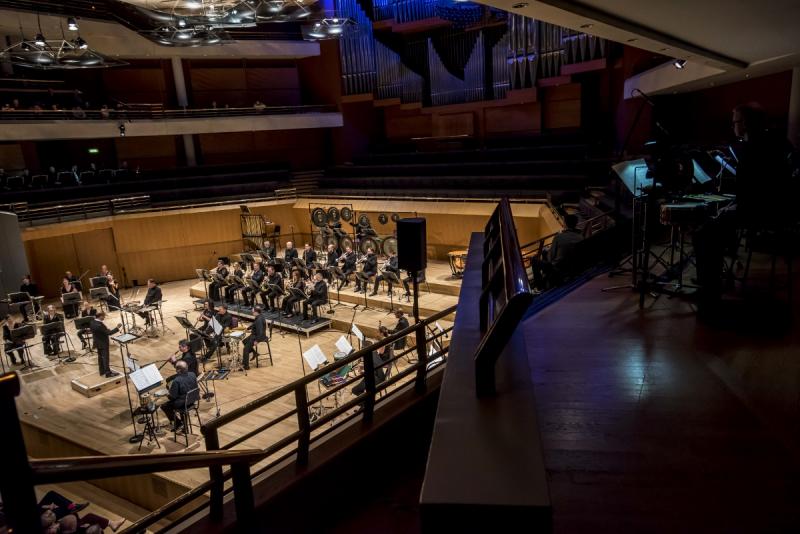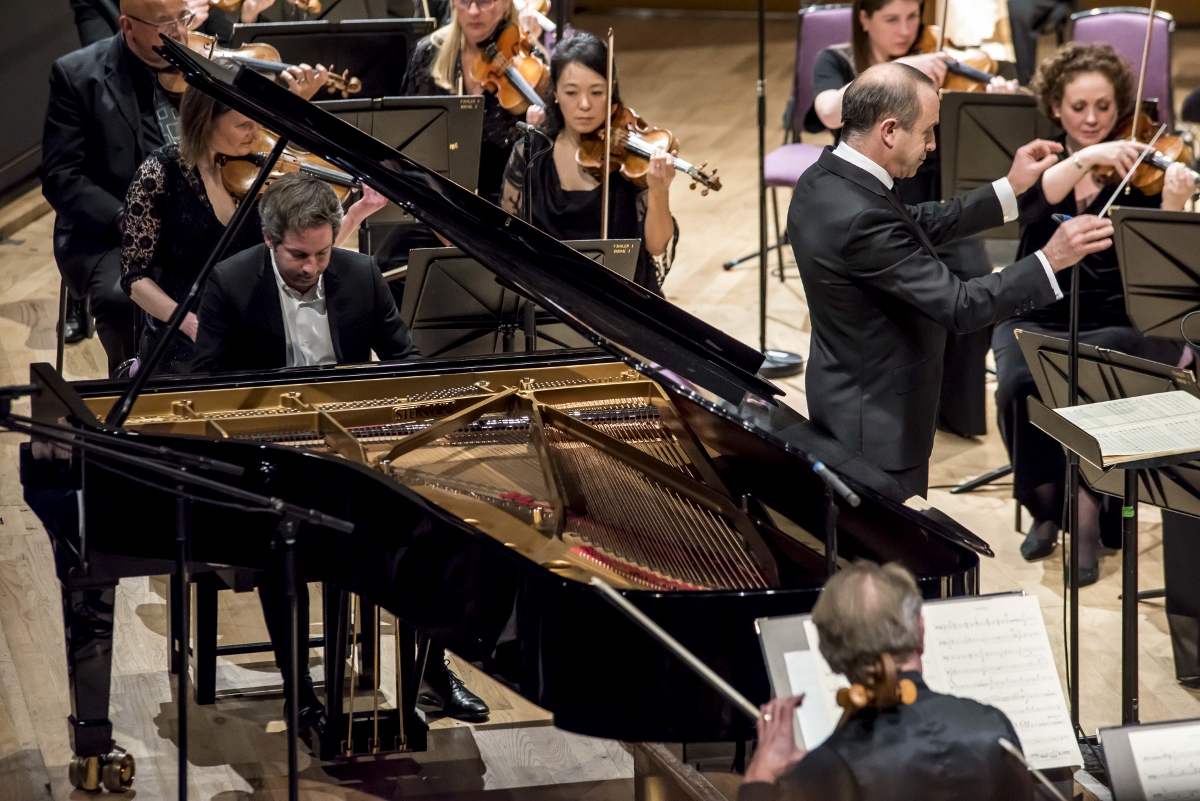Chamayou, BBC Philharmonic, Wigglesworth, Bridgewater Hall, Manchester review - Boulez with bonbons | reviews, news & interviews
Chamayou, BBC Philharmonic, Wigglesworth, Bridgewater Hall, Manchester review - Boulez with bonbons
Chamayou, BBC Philharmonic, Wigglesworth, Bridgewater Hall, Manchester review - Boulez with bonbons
Assurance and sympathy from Mark Wigglesworth for differing French idioms

Top Brownie points for the BBC Philharmonic for being one of the first (maybe the first?) to celebrate the birth centenary of Pierre Boulez this year. His Rituel – in memoriam Bruno Maderna was paired somewhat uneasily with a second half of bonbons by Ravel (it’s his 150th anniversary year, too).
Mark Wigglesworth was the maestro who piloted both parts of the programme, however, showing equally calm assurance and sympathy with their differing idioms.
Boulez’ tribute to another 20th century modernist was the longest piece on the list, and made a suitably solemn tribute as well as providing early occupation for the nine percussionists who were to be needed later for the second suite from Daphnis et Chloé.
There are those who observe a defining fascination with timbre in almost all French music since Debussy, and though that hardly makes a convincing parallel between Boulez and Ravel, the instrumentation of Rituel – in memoriam Bruno Maderna certainly makes an impression in its own right. It may not be so obvious to those who listen to this on the radio when it finally makes it to the airwaves, but in the hall there was the visual impact of separate cohorts of players arranged around the space: 14 brass players, with an array of gongs behind them, central on the platform; other groups at the sides and still others aloft on the auditorium levels above them. They’re used in varying alternations and combinations to create succeeding changes of texture and complexity, in an overall arch structure (comprising for much of the time a succession of what Boulez called versets and répons, following one another as if in a liturgy), which seem to grow and then diminish.
Boulez planned it in an obsession with the number seven, using what he said was an “Asian funeral dirge” of seven notes. There is a sense of solemn obsequy, and a slow, funeral tread is rarely absent from the percussive sounds heard. And a solo oboe seems to act as cantor, particularly at the outset. So the “ritual” takes the form of both quasi-verbal observance and, quite possibly, an outdoor procession.
There are intriguing sonic effects from the undamped resonances and sympathetic vibrations of the gongs, quite separately from the broad slabs of brass sound they introduce and follow, and at the close their fading waves gradually merged into the barely audible hum of the air conditioning – perhaps a realization of what Boulez meant when he said he was evoking both death and survival.  After the 25 minutes of the piece, a break was needed if only to re-set the platform for the more conventional orchestral resources and ground plan of Ravel’s orchestra (which took longer to achieve than all the music heard thus far).
After the 25 minutes of the piece, a break was needed if only to re-set the platform for the more conventional orchestral resources and ground plan of Ravel’s orchestra (which took longer to achieve than all the music heard thus far).
But once the piano had been installed for the Piano Concerto in G – the jazzy one for two hands – we entered a different world. Bertrand Chamayou is a very remarkable pianist (pictured above with Wigglesworth and the orchestra): often tender and thoughtful (and evoking respectful echoes of these qualities among the orchestral wind solos), undemonstrative and at times almost self-effacing, yet performing with brilliance and bewitching virtuosity in his first-movement cadenza. In the enchanting central Adagio all was clean and neo-classical (the movement shaped, with Wigglesworth’s help, to sing out in its high points), and the finale was a romp.
Then came a world premiere – of an arrangement of Ravel for orchestra: his early two-part piano work, Sites auriculaires, having been given instrumentation by Kenneth Hesketh. It must have been an interesting challenge, as Ravel himself orchestrated its first section, “Habanera”, himself when he wrote Rapsodie espagnole.
Hesketh writes that he set out to make “a type of gentle oppositional or negative orchestration” of it, and the uncanny thing is that his version still sounds unmistakably Ravellian. The second of the two short pieces, “Entre cloches”, is if anything, less typical, and more like Rimsky-Korsakov (appropriate enough for the time of the original).
Another brief example followed, this time of Ravel orchestrated by Ravel, in the popular Pavane pour une infante defunte – its reprise exquisitely song-like and beautiful in Mark Wigglesworth’s hands – before, finally, the Daphnis et Chloé suite, which begins with the wonderful musical picture of “Lever du jour” and ends with the exhilarating “Danse Générale” from the ballet.
The whole programme had been promoted on the basis that it contained this music (perhaps mindful that the complete work has been championed in Manchester by Sir Mark Elder with the Hallé, most recently in October 2023), and it fulfilled its promise: the opening skilfully balanced, melodically led and finely proportioned (gorgeous flute playing by Alex Jakeman) under the Wigglesworth baton.
- To be broadcast on Radio 3 on Tuesday 11 March
- More classical reviews on theartsdesk
rating
Share this article
The future of Arts Journalism
You can stop theartsdesk.com closing!
We urgently need financing to survive. Our fundraising drive has thus far raised £49,000 but we need to reach £100,000 or we will be forced to close. Please contribute here: https://gofund.me/c3f6033d
And if you can forward this information to anyone who might assist, we’d be grateful.

Subscribe to theartsdesk.com
Thank you for continuing to read our work on theartsdesk.com. For unlimited access to every article in its entirety, including our archive of more than 15,000 pieces, we're asking for £5 per month or £40 per year. We feel it's a very good deal, and hope you do too.
To take a subscription now simply click here.
And if you're looking for that extra gift for a friend or family member, why not treat them to a theartsdesk.com gift subscription?
more Classical music
 BBC Proms: Le Concert Spirituel, Niquet review - super-sized polyphonic rarities
Monumental works don't quite make for monumental sounds in the Royal Albert Hall
BBC Proms: Le Concert Spirituel, Niquet review - super-sized polyphonic rarities
Monumental works don't quite make for monumental sounds in the Royal Albert Hall
 Frang, Romaniw, Liverman, LSO, Pappano, Edinburgh International Festival 2025 review - sunlight, salt spray, Sea Symphony
Full force of the midday sea in the Usher Hall, thanks to the best captain at the helm
Frang, Romaniw, Liverman, LSO, Pappano, Edinburgh International Festival 2025 review - sunlight, salt spray, Sea Symphony
Full force of the midday sea in the Usher Hall, thanks to the best captain at the helm
 Elschenbroich, Grynyuk / Fibonacci Quartet, Edinburgh International Festival 2025 review - mahogany Brahms and explosive Janáček
String partnerships demonstrate brilliant listening as well as first rate playing
Elschenbroich, Grynyuk / Fibonacci Quartet, Edinburgh International Festival 2025 review - mahogany Brahms and explosive Janáček
String partnerships demonstrate brilliant listening as well as first rate playing
 BBC Proms: Akhmetshina, LPO, Gardner review - liquid luxuries
First-class service on an ocean-going programme
BBC Proms: Akhmetshina, LPO, Gardner review - liquid luxuries
First-class service on an ocean-going programme
 Budapest Festival Orchestra, Iván Fischer, Edinburgh International Festival 2025 review - mania and menuets
The Hungarians bring dance music to Edinburgh, but Fischer’s pastiche falls flat
Budapest Festival Orchestra, Iván Fischer, Edinburgh International Festival 2025 review - mania and menuets
The Hungarians bring dance music to Edinburgh, but Fischer’s pastiche falls flat
 Classical CDs: Hamlet, harps and haiku
Epic romantic symphonies, unaccompanied choral music and a bold string quartet's response to rising sea levels
Classical CDs: Hamlet, harps and haiku
Epic romantic symphonies, unaccompanied choral music and a bold string quartet's response to rising sea levels
 Kolesnikov, Tsoy / Liu, NCPA Orchestra, Chung, Edinburgh International Festival 2025 review - transfigured playing and heavenly desire
Three star pianists work wonders, and an orchestra dazzles, at least on the surface
Kolesnikov, Tsoy / Liu, NCPA Orchestra, Chung, Edinburgh International Festival 2025 review - transfigured playing and heavenly desire
Three star pianists work wonders, and an orchestra dazzles, at least on the surface
 BBC Proms: Láng, Cser, Budapest Festival Orchestra, Iván Fischer review - idiomatic inflections
Bartók’s heart of darkness follows Beethoven’s dancing light
BBC Proms: Láng, Cser, Budapest Festival Orchestra, Iván Fischer review - idiomatic inflections
Bartók’s heart of darkness follows Beethoven’s dancing light
 Weilerstein, NYO2, Payare / Dueñas, Malofeev, Edinburgh International Festival 2025 review - youthful energy and emotional intensity
Big-boned Prokofiev and Shostakovich, cacophonous López, plus intense violin/piano duo
Weilerstein, NYO2, Payare / Dueñas, Malofeev, Edinburgh International Festival 2025 review - youthful energy and emotional intensity
Big-boned Prokofiev and Shostakovich, cacophonous López, plus intense violin/piano duo
 theartsdesk at the Three Choirs Festival - Passion in the Cathedral
Cantatas new and old, slate quarries to Calvary
theartsdesk at the Three Choirs Festival - Passion in the Cathedral
Cantatas new and old, slate quarries to Calvary
 BBC Proms: Estonian Philharmonic Chamber Choir, Kaljuste review - Arvo Pärt 90th birthday tribute
Stillness and contemplation characterise this well sung late-nighter
BBC Proms: Estonian Philharmonic Chamber Choir, Kaljuste review - Arvo Pärt 90th birthday tribute
Stillness and contemplation characterise this well sung late-nighter

Add comment